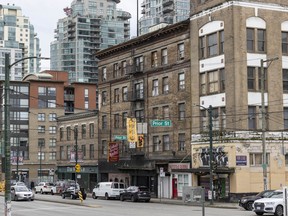New computer modelling suggests 6,300 older buildings would be heavily damaging, killing or maiming 1,350 people

Article content
A major earthquake would be devastating and deadly for Vancouver, according to the latest in a long line of warning reports.
The computer modelling in a new City of Vancouver report estimates that a magnitude 7.2 earthquake in the Georgia Strait could heavily damage 6,100 buildings in the city, leading to more than 1,350 deaths and severe injuries.
It would also lead to the estimated displacement of more than one third of city residents and workers for more than three months and result in $17 billion in financial losses.
Advertisement 2
Article content
As a result of the report, Vancouver city councillors will consider Tuesday a recommendation to have staff come up with a plan by 2025 to reduce the significant seismic risk that exists in privately owned buildings in Vancouver. That starts with consulting owners of rental buildings and condos, landlords, tenants, renter groups, and Indigenous agencies.

The report said the highest risk is with older brick, wood and concrete buildings in the West End, the Downtown Eastside, Chinatown, Strathcona, the downtown, Kitsilano, Fairview, and Mount Pleasant neighbourhoods.
It is the latest report calling for steps to reduce the seismic risk of privately owned buildings. This effort started after a 2016 investigation by Postmedia News revealed the city had failed to create a plan to reduce the seismic hazard of the city’s older private buildings, numbering in the thousands, despite identifying a need to do so as far back as 1994, now 30 years ago.
Carlos Ventura, a professor in structural and earthquake engineering at the University of B.C., said Friday he is familiar with the city report, and the findings reflect reality.
Article content
Advertisement 3
Article content
Ventura said the million-dollar question is whether the city will have the energy and political will to create and implement a plan that will cost the city, building owners and others a lot of money.
Ventura, who heads UBC’s earthquake engineering research facility, said that in the past, reports have been made public, they have been commented on, and then interest dies down.
“I am more hopeful this time,” said Ventura, pointing to the city’s hiring of former San Francisco seismic planner Micah Hilt in 2017 as the city’s lead seismic planner. Hilt was one of the two authors of this report.
Keith Porter, the chief engineer for the Institute for Catastrophic Loss Reduction, who has been involved in efforts to mandate seismic retrofits of privately owned buildings in San Francisco and Los Angeles, said unless there is widespread buy-in from the ground up, there is little likelihood of a city making significant progress.
The key issue is cost, which will need public support if the city is to order mandatory retrofits, he said.
The new city report offers no solution to the cost problem, and city staff said provincial and federal help will be needed.
Advertisement 4
Article content
Porter said cities like Vancouver have to confront the fact that either there is a reasonable cost now of one 10 times or higher after a catastrophe.
“An earthquake represents a nearly existential threat to a city, one which it may not recover from,” said Porter.
Ventura echoed that view, saying you only have to look to the devastation in Turkey in 2023 or Christchurch, New Zealand, in 2011 to see the consequences of not adequately dealing with the seismic risk to private buildings. Christchurch is still rebuilding.
The staff report to council noted that a major earthquake is “one the most significant risks to public safety Vancouver faces.”
One of the concerns is people who would be most affected by a major earthquake are those least able to prepare and reduce the risk. The report noted the most-at-risk buildings contain nearly all of the city’s purpose-built rental units, including for low-income tenants and seniors, and small businesses serving neighbourhoods.
The report’s other author is Tiegan E. Hobbs, a research scientist with Natural Resources Canada.
Advertisement 5
Article content
In a 1994, the city considered mandatory seismic assessments, deadlines for mandatory upgrades, public disclosure of the seismic risk of buildings and possibly even requiring signs on buildings that weren’t upgraded. Also considered at the time were incentives for seismic upgrades, such as waving building-permit fees, property-tax relief and low-interest loans.
The City of Vancouver also developed plans to reduce the seismic risk of older buildings in 2000 and again in 2011, but never followed through.
There is no law in Vancouver or any other B.C. municipality that requires older buildings to meet modern seismic safety standards. Some buildings in Vancouver have received seismic upgrades when changes-of-use or major renovations have triggered newer building requirements. Some public buildings have also received seismic upgrades.
The City of Vancouver lags behind other west coast jurisdictions such as California, which has a decades-long history of tackling seismic risk in buildings, including in private buildings. That state has used tax and fee incentives to reduce seismic risk and also required mandatory seismic retrofits.
Advertisement 6
Article content
Recommended from Editorial
-

Earthquake detection system providing seconds of warning is activated in B.C.
-

Over 20,000 Vancouver secondary students in schools that could collapse in earthquake: Report
-

How much will the ground shake? Scientists creating first detailed maps of Metro Vancouver’s earthquake hazards
-

Flurry of mini earthquakes off Vancouver Island hints at undersea expansion
Bookmark our website and support our journalism: Don’t miss the news you need to know — add VancouverSun.com and TheProvince.com to your bookmarks and sign up for our newsletters here.
You can also support our journalism by becoming a digital subscriber. With a subscription, you’ll get unlimited access to The Vancouver Sun online, as well as the ePaper and our app. Support us by subscribing today: The Vancouver Sun.
Article content






Comments